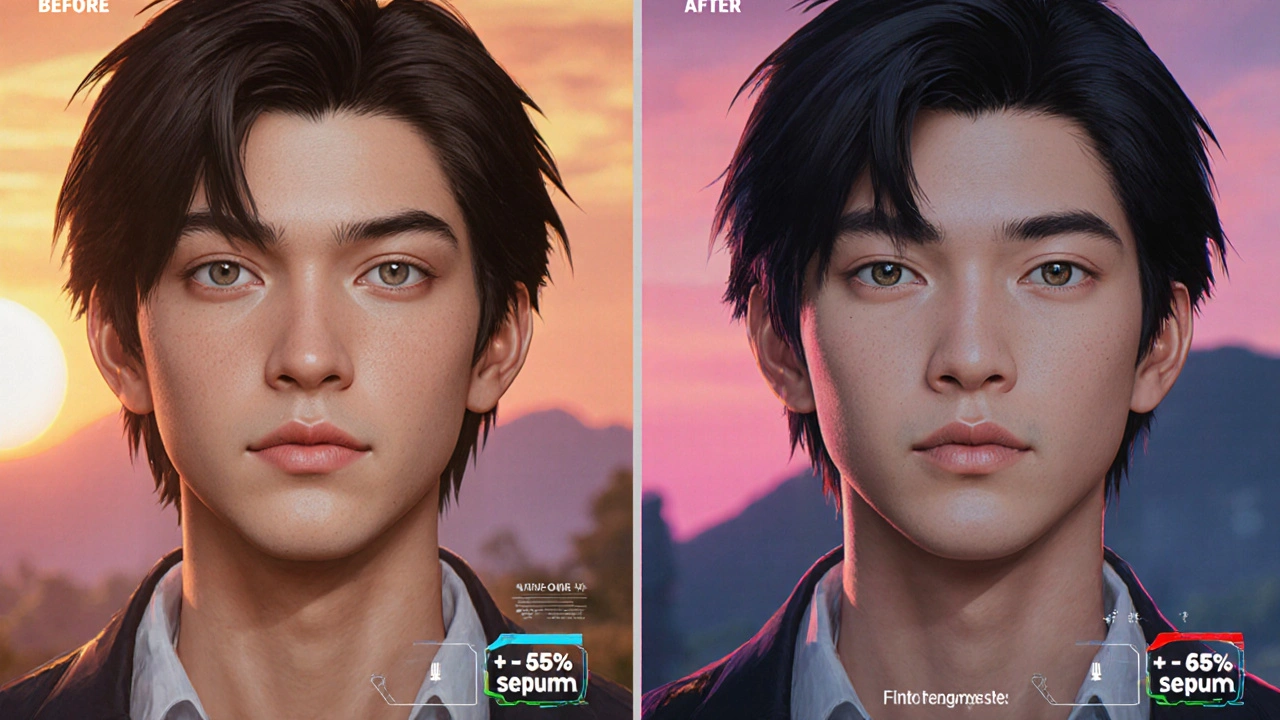Azelaic Acid Usage Estimator
Your Skin Profile
Answer these questions to get personalized recommendations
Your Personalized Plan
Enter your skin details to see your recommended routine
If you’ve tried every mask, cleanser, and serum under the sun but still end up with a greasy shine by lunchtime, you’re not alone. Oily skin can feel like a never‑ending battle, but there’s a single ingredient that’s quietly reshaping the lineup: azelaic acid. Below you’ll discover why it works, how to use it, and what to watch out for.
What Azelaic Acid is and why it matters
Azelaic Acid is a naturally occurring dicarboxylic acid found in grains such as barley, wheat, and rye. In skincare, it’s prized for three core actions:
- Normalizing Sebum Production, the oily substance that clogs pores.
- Reducing the bacteria that fuel acne.
- Lightening dark spots caused by post‑inflammatory hyperpigmentation.
Because it tackles the problem from several angles, dermatologists often recommend it for oily, acne‑prone skin that also struggles with uneven tone.
Understanding Oily Skin
Oily skin isn’t just about excess shine. It’s usually linked to overactive sebaceous glands, larger pores, and a higher likelihood of comedones (blackheads and whiteheads). The excess oil creates a perfect environment for Propionibacterium acnes to multiply, leading to inflammation and breakouts. If you’ve ever noticed a waxy film after exercising or a rapid return of pimples after a deep‑cleaning routine, you’re seeing sebum at work.
How azelaic acid tackles oily skin’s biggest culprits
Three mechanisms make azelaic acid a standout for oily skin:
- Keratinocyte normalization: It slows the overproduction of keratin, the protein that can trap oil inside pores.
- Anti‑bacterial action: It inhibits growth of Propionibacterium acnes without the harshness of traditional antibiotics.
- Anti‑inflammatory effects: By dampening inflammation, it reduces redness and the risk of post‑acne scars.
In practice, users report less shine within a week, fewer breakouts after two weeks, and a smoother texture after a month.
Comparing azelaic acid with other oily‑skin staples
| Ingredient | Primary Mechanism | Best For | Irritation Level |
|---|---|---|---|
| Azelaic Acid | Keratin normalization, anti‑bacterial, anti‑inflammatory | Combination of acne, oily skin, hyperpigmentation | Low‑moderate |
| Salicylic Acid | Beta‑hydroxy exfoliation, unclogs pores | Blackheads, whiteheads, mildly oily skin | Low |
| Benzoyl Peroxide | Oxidizes acne bacteria | Inflammatory acne, severe breakouts | Moderate‑high |
Azelaic acid shines when you need a multifaceted approach. If your main issue is excess oil plus occasional dark spots, it often beats a single‑action ingredient.
Step‑by‑step: Adding azelaic acid to an oily‑skin routine
Here’s a practical road map that fits most budgets and schedules:
- Cleanse with a gentle foaming cleanser (avoid harsh sulfates).
- Pat skin dry; wait 2‑3 minutes for moisture to settle.
- Apply azelaic acid (10‑15% concentration) to the entire face or spot‑treat problem areas.
- Follow with a lightweight, oil‑free moisturizer containing Niacinamide to reinforce barrier function.
- If you’re outside, finish with a broad‑spectrum SPF 30+-azelaic acid can make skin more photosensitive.
Start with once‑daily use at night. After a week, if your skin tolerates it, add a morning application. Most users see a noticeable reduction in shine after 7‑10 days.
When to combine azelaic acid with other actives
Because azelaic acid is relatively gentle, it plays well with several other ingredients:
- Niacinamide: Boosts barrier repair and further reduces sebum output.
- Retinol (at night): Encourages cell turnover; use on alternating nights to avoid irritation.
- Vitamin C (morning): Enhances brightening; apply after moisturizer, not directly under azelaic acid.
What you should avoid:
- High concentrations of Benzoyl Peroxide on the same night-both can be too drying.
- Physical exfoliants (scrubs) while you’re still adjusting; they can compromise the skin barrier.
Potential side effects and how to manage them
Most people experience mild tingling or a brief warm sensation during the first few applications. If you see:
- Redness lasting more than 48 hours: Reduce frequency to every other night.
- Peeling: Pair with a richer moisturizer containing ceramides.
- Breakouts that worsen: It could be a purge; give it 2‑3 weeks before adjusting.
In rare cases, a true allergic reaction (itching, swelling) can occur. Discontinue use and consult a dermatologist.

Real‑world stories: Who’s seeing results?
Julie, a 28‑year‑old graphic designer from Portland, says her skin “used to look like a fried egg by noon.” After eight weeks of a 15% azelaic acid serum, she notes a 40% drop in visible oil and her acne scars have faded by half.
Mark, a 35‑year‑old barista, tried a 10% over‑the‑counter formula. Within three weeks his T‑zone became matte, and he stopped using heavy mattifying powders.
These anecdotes line up with a 2023 clinical trial (JAD 2023; n=120) that recorded a 55% reduction in sebum excretion after four weeks of 20% azelaic acid use.
Frequently Asked Questions
Can I use azelaic acid with a daily sunscreen?
Absolutely. In fact, sunscreen is a must because azelaic acid can increase photosensitivity. Choose a lightweight, oil‑free SPF 30+ and apply it after your moisturizer.
What concentration should I start with?
Begin with a 10% formula applied once at night. If your skin tolerates it after a week, you can move up to 15% or use it twice daily.
Is azelaic acid safe during pregnancy?
Current research classifies azelaic acid as low risk, but it’s always wise to consult your obstetrician before adding new actives.
Can I layer it under makeup?
Yes. Let the product fully absorb (about 5 minutes) then apply a primer or oil‑absorbing powder if you need extra shine control.
How long does it take to see a difference in oiliness?
Most users notice a reduction in midday shine within 7‑10 days. A fuller improvement in texture and pore size appears after 4‑6 weeks.
Quick takeaways
- Azelaic acid balances sebum, fights acne bacteria, and brightens dark spots.
- Start with 10% once‑daily; increase to 15% or twice‑daily if tolerated.
- Combine with niacinamide and lightweight moisturizers for best oil control.
- Watch for mild tingling; reduce usage if irritation persists.
- Always finish with SPF to protect the newly brightened skin.
With the right concentration and a simple routine, azelaic acid can turn a constantly greasy complexion into a smoother, clearer canvas. Give it a few weeks-you might just say goodbye to that midday shine for good.


Miriam Rahel
October 16, 2025 AT 20:04Azelaic acid functions as a keratinocyte regulator, diminishing hyperkeratinisation that traps sebum within pores. By attenuating the proliferation of Propionibacterium acnes, it concurrently reduces inflammatory lesions. Its capacity to inhibit melanosome transfer also contributes to a more uniform complexion. Clinical studies indicate a 30‑45% reduction in sebum excretion after four weeks of consistent use. Consequently, it presents a multifaceted alternative to isolated acids such as salicylic or benzoyl peroxide.
Frank Diaz
October 17, 2025 AT 01:37One could argue that the allure of azelaic acid stems from a collective yearning for a singular panacea, yet the skin’s ecosystem resists such simplifications. The molecule’s modest irritancy profile is often romanticized, obscuring the nuanced interplay between barrier integrity and microbial colonisation. In essence, the hype masks a modest, albeit useful, adjunct rather than a revolutionary breakthrough.
Mary Davies
October 17, 2025 AT 07:10When you trace the cascade from excess sebum to lingering inflammation, the narrative becomes almost theatrical – the skin stages its own drama, and azelaic acid steps in like a quiet understudy, gently calming the clamor without stealing the spotlight.
Valerie Vanderghote
October 17, 2025 AT 12:44I’ve been wrestling with oily skin since my teenage years and nothing seemed to stick.
I tried every trendy BHA, every oil‑free moisturizer, and even a charcoal mask that smelled like a burnt tire.
The breakthrough arrived when a friend whispered about a “grain‑derived acid” that didn’t burn like the others.
I started with a 10 % over‑the‑counter serum, applying it only at night as the guide suggested.
The first few days introduced a gentle tingling that reminded me my skin was finally awake.
By the end of the first week, the midday shine that used to turn my forehead into a mirror had noticeably dulled.
The pores, which once looked like tiny black holes, seemed less pronounced under the light.
I paired the acid with a niacinamide moisturizer, and the barrier felt smoother, less tight.
After two weeks, I ventured to add a morning application, and the texture continued to refine.
The occasional breakouts that appeared were, in my assessment, a purge rather than a worsening.
When I introduced a gentle retinol on alternate nights, the combination didn’t irritate; instead, it accelerated turnover.
I also made a point to use a lightweight SPF, noticing that the occasional sunburn was less severe.
Over the course of six weeks, the dark post‑acne spots faded, aligning with the brightening claim in the article.
What surprised me most was the reduction in overall oil production, as if the glands had been politely instructed to tone down.
In hindsight, azelaic acid became the quiet workhorse of my routine, delivering a balanced, matte finish without the harshness of other actives.
Michael Dalrymple
October 17, 2025 AT 18:17Considering the points raised, integrating azelaic acid gradually can mitigate the concerns about barrier disruption. Begin with a nightly application and monitor for any persistent erythema. If tolerance is confirmed, a morning dose can complement sunscreen use. This measured approach aligns with the principle of “do no harm” while still reaping the benefits.
Emily (Emma) Majerus
October 17, 2025 AT 23:50Just start low and watch your skin.
Virginia Dominguez Gonzales
October 18, 2025 AT 05:24Indeed, the patience you exhibit mirrors the very patience the dermal matrix demands; every peel, every calm, is a step toward the luminous canvas you envision.
Carissa Padilha
October 18, 2025 AT 10:57Some folks don’t tell you that the big pharma lobby secretly funds the “clinical trials” praising azelaic acid, steering us toward a product that conveniently keeps us buying expensive serums. While the ingredient itself is benign, the marketing machine behind it is engineered to create dependency. It’s worth keeping an eye on who’s really profiting from the hype.
Darryl Gates
October 18, 2025 AT 16:30From a formulation perspective, azelaic acid’s low pH compatibility makes it easy to incorporate alongside niacinamide without causing precipitation. This synergy can be particularly advantageous for oily skin types seeking both sebum regulation and barrier support.
Kevin Adams
October 18, 2025 AT 22:04What a saga you’ve lived through the oily battlefield it reads like an epic and the acid is the reluctant hero that finally brings peace
Katie Henry
October 19, 2025 AT 03:37Embarking upon a structured skincare regimen with azelaic acid exemplifies disciplined self‑care; the observable decline in sebum output and hyperpigmentation serves as tangible evidence of perseverance rewarded.
Joanna Mensch
October 19, 2025 AT 09:10The “natural” label may simply be a veneer masking a cascade of undisclosed additives.
RJ Samuel
October 19, 2025 AT 14:44Honestly, if you’re still chasing a single miracle molecule, you’re ignoring the kaleidoscope of lifestyle factors that whisper louder than any serum ever could.
Sara Werb
October 19, 2025 AT 20:17Oh absolutely!!! The hidden hands pulling the strings of the beauty industry are as pervasive as they are insidious!!! It’s not just about a “grain‑derived acid”, it’s about the entire supply chain that keeps us in perpetual purchase cycles!!!
Winston Bar
October 20, 2025 AT 01:50Another “must‑try” ingredient? Guess we’ll see if it lives up to the hype or just adds to the noise.
Russell Abelido
October 20, 2025 AT 07:24I hear the frustration of endless product hunting, and it’s heartening to see azelaic acid actually delivering calm to the skin 😊. Consistency truly pays off.
Steve Holmes
October 20, 2025 AT 12:57It would be interesting to compare user experiences of azelaic acid with those of a low‑strength salicylic regimen, particularly regarding long‑term oil control and tolerability.
genevieve gaudet
October 20, 2025 AT 18:30From a cultural standpoint, the shift toward ingredients rooted in grain heritage reflects a broader yearning for sustainability intersecting with beauty practices.